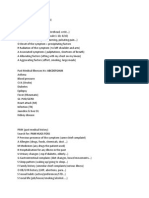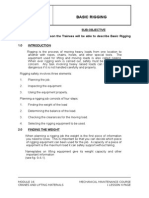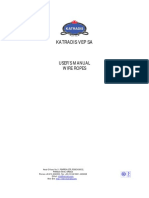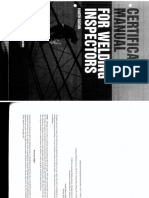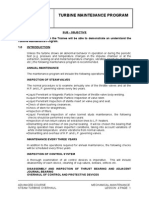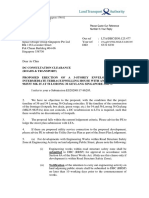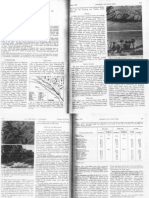Lesson Rigging Safety
Lesson Rigging Safety
Uploaded by
mister pogiCopyright:
Available Formats
Lesson Rigging Safety
Lesson Rigging Safety
Uploaded by
mister pogiOriginal Description:
Original Title
Copyright
Available Formats
Share this document
Did you find this document useful?
Is this content inappropriate?
Copyright:
Available Formats
Lesson Rigging Safety
Lesson Rigging Safety
Uploaded by
mister pogiCopyright:
Available Formats
LESSON
5
LECTURE
RIGGING SAFETY
SUB-OBJECTIVE
At the end of the Lesson the Trainees i!! "e a"!e to des#ri"e itho$t error
Ri%%in% Safet&'
(') FORE*OR+
The Law requires that all Chains, Ropes and Lifting Tackle shall be
examined by a Competent Person every six months !hen not in use,
therefore, all lifting tackle should be carefully stored in the proper
place so that it may be easily located and made available when
inspections or tests are due
Remember, that the safety of yourself and others depends upon the
condition of the tackle used, so report doubtful equipment to your
"upervisor and never mistreat appliances
,') RULES - GENERAL
# $ach item of equipment must be examined before use
defective appliances must be brought to the attention of
your "upervisor
% &o chain, rope or other appliance may be used for any
load exceeding the "afe !orking Load '"!L( stamped
on the appliance or as shown in the charts and in the
tables shown in the Lifting Tackle "tores
) *nder no circumstances must the load exceed the rated
capacity of the Crane
+ !here possible, learn the weight of the load and the
weight of your Lifting Tackle, since the total weight to be
lifted is the sum of the two ,lways use Tackle of ample
dimensions when loads of unknown weight are to be
lifted
- The Crane .ook must be positioned over the load to
prevent the load swinging when raised Clear and
correct signals must be given to the Crane /river by the
"linger or authori0ed person responsible for the lift
&ote1only authori0ed person to give the signal to the
Crane /river for any specific lift "ee 2ig #31-1# for
hand signals from slingers to crane operator
MECHANICAL MAINTENANCE COURSE MODULE 9
LESSON 5 PAGE 1 CRANES AND LIFTING MATERIALS
3 4ake sure that the load is free before lifting and avoid
being trapped when the strain is taken .alt the lifting of
the load after it has been raised a few inches to ensure
that it is securely slung before continuing with the lift
5 , void carrying the load over the heads of persons and
where necessary warn persons in the vicinity to keep
clear
6 !ire Rope "lings and Chains must never be shortened
by tying knots in them, or by wrapping them around the
Crane .ook, neither must Chains be 7oined or shortened
by means of 8olts or !ires *se the correct length of
"ling or approved device for ad7usting the length of the
"ling
9 "ling should be protected from sharp edges by soft wood
or other suitable packing Care should also be taken to
avoid loads resting on "lings as this will cause
deterioration "ee 2ig #31-1- and 2ig #31-13
#: The Crane must not be allowed to move with "lings
trailing from the .ook in a dangerous manner !here
low headroom etc, limits the use of the full length of a
2ibre Rope "ling, the excess must be hitched back in a
safe manner
## ,ll end links, rings or shackles should ride freely upon
the Crane .ook
#% !hen multi1slings are used, each leg of the "ling should,
wherever possible, be loaded evenly "lings of sufficient
length should be selected to avoid flattened angles
between legs but not of such length as to seriously
reduce headroom
#) The "afe !orking Load of a "ling is reduced by the
widening of the angle between legs of "lings !hen
lifting slabs, plates, reels or bulky ob7ects care must be
taken to ensure that the angle of the "ling does not
exceed the stated angle "ee 2ig #31-1% ; #31-1) The
effect of on "lings when changing the angle and also see
2ig #31-1+ .ow to reduce the load on "lings
#+ , load must never be carried loosely in the loop of a
"ling, or "lings 4ake sure the bight is properly
ad7usted
MODULE 9 MECHANICAL MAINTENANCE COURSE
CRANES AND LIFTING MATERIALS LESSON 5 PAGE 2
15. <n no account must any person ride the .ook or travel on
any part of the load being carried by a Crane, except when
authori0ed passenger carrying equipment is used, eg
8osun=s Chair, Cradle etc
Fi%' (--5-('
MECHANICAL MAINTENANCE COURSE MODULE 9
LESSON 5 PAGE 3 CRANES AND LIFTING MATERIALS
*IRE RO.E SLINGS
# , !ire Rope "ling, the eye of which has been made by a
>Liverpool "plice> one formed by twisting the strands
around the lay of the rope, must never be used singly
because when loaded the rope is liable to untwist, thus
allowing the splice to open and split
% !ire Ropes should be kept lubricated and not allowed to
become rusty Check the condition of them on receipt
and return to the store after use so that they can be
properly maintained
) , !ire Rope must not be used if the number of visible
broken wires appear to be excessive and should be
reported to your "upervisor
FIBRE RO.E SLINGS
# 2ibre Rope "lings must be inspected before use and
frequently checked whilst in use !hen stored, they
should be hung to avoid contamination by moisture,
acids etc
% *ntwisting the strands at intervals of several feet to
expose the interior should inspect ropes and any serious
defects reported to your "upervisor
EYEBOTLS - C/AC0LES ETC
# <nly the proper pin must be used in "hackles Loose
bolts, bars etc, must not be used
% *se eyebolts with a collar wherever possible, ensuring
that the eyebolt is screwed down fully "ling directly from
the eyebolt and never pass the leg of a "ling through
more than one eyebolt
SLING ANGLES
The stresses in the legs of a sling increase as the angle between them
increases *sing the human body and two buckets filled with water it
is not difficult to demonstrate the effects of lifting a load at narrow and
wide angles The arms represent slings and lift angles
Fi%' 1-5-,' shos the ar2s 3erti#a! and a reasona"!& eas& !iftin%
#ondition'
MODULE 9 MECHANICAL MAINTENANCE COURSE
CRANES AND LIFTING MATERIALS LESSON 5 PAGE 4
Fi%' 1-5-,'
Fi%' 1-5-4' shos the ar2 stret#hed "e&ond its !i2it' The "od&
and s!in%s are not desi%ned to ta5e ne#essar& strains'
Fi%' 1-5-4'
MECHANICAL MAINTENANCE COURSE MODULE 9
LESSON 5 PAGE 5 CRANES AND LIFTING MATERIALS
Fi%' (--5-6' Effe#t of an%!e on s!in%s'
4') 7OVE7ENT AN+ STAC0ING OF LOA+S
# ,lways be alert for the movement of road and rail traffic
whilst slinging loads, especially when stacking on
stationary vehicles or wagons The driver of a vehicle
should apply the hand brake prior to loading or off1
loading operations ?n the case of trailers, check that the
hand brake is applied and@or wheels scotched
% "tack materials securely and make provision where
necessary for its subsequent removal
) $nsure that there is a firm foundation for the stack and
allow for the removal of slings without disturbance
8ricks are not reliable packing
) !agons should not be overloaded and care should be
exercised to avoid pro7ections when placing loads on
wagons, as this could cause danger in transit
+ Centre the load onto trucks, trailers, etc, to avoid the
possibility of tipping Load to the /rivers instructions
MODULE 9 MECHANICAL MAINTENANCE COURSE
CRANES AND LIFTING MATERIALS LESSON 5 PAGE 6
- 4ake full use of suitable wedges when stacking reels,
drums bars, pipes etc
3 ,void obstructing gangways when stacking materials and
never stack loads within ) ft of rail lines
6') .RO.ER USE OF SLINGS
6'( SLINGS AN+ /ITC/ES
The type of sling or hitch to be used should be determined from the
shape of the load and by the flexibility, and condition of the rope or
wire ?n lifting multiple ob7ects
"uch as a load of lumber or steel sheathing, the sling should bind on
the load sufficiently to prevent slipping of the individual pieces
?n handling single pieces, such as timbers, posts or piles, a timber
hitch with % half hitches 'or a similar hitch( should be used
?n using rope as straps for hooking on to tackle blocks there should be
the same number of parts of rope in the strap as there are moving
parts in the tackle
2or instance, if triple block tackle is used, there should be six parts of
rope for the strap
MECHANICAL MAINTENANCE COURSE MODULE 9
LESSON 5 PAGE 7 CRANES AND LIFTING MATERIALS
Fi%' 1-5-5'
MODULE 9 MECHANICAL MAINTENANCE COURSE
CRANES AND LIFTING MATERIALS LESSON 5 PAGE 8
Fi%' 1-5--'
MECHANICAL MAINTENANCE COURSE MODULE 9
LESSON 5 PAGE 9 CRANES AND LIFTING MATERIALS
5') SLINGING 7ET/O+ AN+ BALANCING T/E *EIG/T
Reeving "ling using single sling A Lifting short lengths of tube, bars or
rods "afety 1 ensure materials closely packed before lifting
Fi%' 1-5-()'
MODULE 9 MECHANICAL MAINTENANCE COURSE
CRANES AND LIFTING MATERIALS LESSON 5 PAGE 10
Reeving "ling using two slingsA lifting tubes, bars or rods
Fi%' 1-5-(('
/ouble !rap "lingsA the /ouble !rap "ling grips the load and helps
to prevent the load from slipping side ways out of the sling
Fi%' 1-5-(,'
SLINGING 7ET/O+S
Cradle "lingA lifting coils of strip steel
"afety 1 packing should be used on all sharp edges
MECHANICAL MAINTENANCE COURSE MODULE 9
LESSON 5 PAGE 11 CRANES AND LIFTING MATERIALS
Fi%' 1-5-(4'
Cradle "lingA lifting boilers and packing cases
Fi%' 1-5-(6'
MODULE 9 MECHANICAL MAINTENANCE COURSE
CRANES AND LIFTING MATERIALS LESSON 5 PAGE 12
Fi%' 1-5-(5'
Fi%' 1-5-(5
MECHANICAL MAINTENANCE COURSE MODULE 9
LESSON 5 PAGE 13 CRANES AND LIFTING MATERIALS
8UESTIONS
# True or 2alse The law requires that all chains, rapes and lifting tackle
shall be examined by a competent person every six months
% True or 2alse ,s general safety rules their is no need to examined
each item be for use
) True or 2alse '"!L( means "afe working load
+ True or 2alse *nder emergency circumstances load can be
exceeded the rated capacity of the crane
- True or 2alse The crane must be positioned over the load to prevent
the load swinging when raised
3 True or 2alse ,void carrying the load over the heads of persons
5 True or 2alse The safe working load of a sling is increased by the
widening of the angle between legs of slings
FILL IN T/E BLAN0S'
6 2ibre rope slings must beBBBBBBBBBBBBBBBBBBBBBBBBbefore use and
frequentlyBBBBBBBBBBBBBBBwhilst in use
9 <nly the proper BBBBBBBBBBBBBBBBBBBBBmust be used in shackles
LooseBBBBBBBBBBBBBBBB, BBBBBBBBBBBBBBBBBBBetc must not be
used
#: "lings should be protected from
BBBBBBBBBBBBBBBBBBBBBBBBBBBedges by soft
BBBBBBBBBBBBBBBBBBBBor other suitable packing
MODULE 9 MECHANICAL MAINTENANCE COURSE
CRANES AND LIFTING MATERIALS LESSON 5 PAGE 14
You might also like
- TrestlesDocument6 pagesTrestlesozcan100% (1)
- Mooring OperationsDocument1 pageMooring OperationsTom AlexNo ratings yet
- SPM (Single Point Mooring) or SBM OperationsDocument9 pagesSPM (Single Point Mooring) or SBM OperationsGiorgi Kandelaki100% (2)
- Basic Introduction To Mooring Winches: Automatic Tension Mooring Winch (Self-Tension Winch)Document6 pagesBasic Introduction To Mooring Winches: Automatic Tension Mooring Winch (Self-Tension Winch)Behendu Perera100% (2)
- SWP-06 Lifting Operation DaimanDocument4 pagesSWP-06 Lifting Operation DaimanHassan AbdullahNo ratings yet
- Winch Safety TrainingDocument27 pagesWinch Safety Trainingaymenmoataz100% (1)
- Mnemonics For Clinical ExamDocument20 pagesMnemonics For Clinical ExamDrAmeen1976100% (3)
- Dark Void (Official Prima Guide)Document161 pagesDark Void (Official Prima Guide)mikel4carbajoNo ratings yet
- David Greig's TheatreDocument293 pagesDavid Greig's TheatreYİĞİT SÜMBÜLNo ratings yet
- Cipher - Core Rulebook (bmg0002) PDFDocument230 pagesCipher - Core Rulebook (bmg0002) PDFe112397100% (3)
- Instructions For The Safe Use Of: Wire Rope SlingsDocument2 pagesInstructions For The Safe Use Of: Wire Rope SlingsStuartWilliamGlennieNo ratings yet
- Chain Slings Inspection Best PracticeDocument11 pagesChain Slings Inspection Best PracticeMohana RangeshNo ratings yet
- Correct Usage Instructions For Lifting EquipmentDocument6 pagesCorrect Usage Instructions For Lifting Equipmentmiraç burak navruzNo ratings yet
- 6-Safety in DrillingDocument31 pages6-Safety in DrillingrahulNo ratings yet
- Operating Procedures For Derricks Including Union PurchaseDocument5 pagesOperating Procedures For Derricks Including Union PurchasehutsonianpNo ratings yet
- Crane Training Handbook With GPR 8719.1B UpdateDocument558 pagesCrane Training Handbook With GPR 8719.1B Updatemhd abdou100% (4)
- Lesson Basic RiggingDocument15 pagesLesson Basic Riggingmister pogiNo ratings yet
- Lifting Beams and SpreadersDocument2 pagesLifting Beams and SpreadersNadeem MalikNo ratings yet
- Snap Back Zones - MGM 308Document8 pagesSnap Back Zones - MGM 308morgoths100% (1)
- F390se.24 GC PDFDocument44 pagesF390se.24 GC PDFDennis XenosNo ratings yet
- Instructions For The Safe Use Of: EyeboltsDocument2 pagesInstructions For The Safe Use Of: Eyeboltsdsn_sarmaNo ratings yet
- Notes On Precautions While Rigging of LaddersDocument5 pagesNotes On Precautions While Rigging of Laddersmithilassi69No ratings yet
- SWP-10 Loading & Unloading Using Lorry & Mobile Crane DaimanDocument2 pagesSWP-10 Loading & Unloading Using Lorry & Mobile Crane DaimanHassan AbdullahNo ratings yet
- 2.1. Anchor Windlass and Cargo Windlass - DimasDocument5 pages2.1. Anchor Windlass and Cargo Windlass - Dimasidris fahmi17No ratings yet
- Ra 08 Safe Mooring PracticeDocument3 pagesRa 08 Safe Mooring PracticeNelum PereraNo ratings yet
- Slinging Tubulars, Scaffold, BeamsDocument3 pagesSlinging Tubulars, Scaffold, BeamsAngel AngeleyeNo ratings yet
- Is 12735 (1994) Wire Rope Slings PDFDocument17 pagesIs 12735 (1994) Wire Rope Slings PDFLALATENDU MAHANTANo ratings yet
- Wire Rope Slings SI 2.3Document2 pagesWire Rope Slings SI 2.3reda mesbahNo ratings yet
- Tow LinesDocument11 pagesTow Linesbill baileyNo ratings yet
- Mooring and UnmooringDocument7 pagesMooring and UnmooringDnv Bailey0% (1)
- Wire Rope Slings Si 2 - 2 EmmDocument2 pagesWire Rope Slings Si 2 - 2 EmmheppyfaebanffNo ratings yet
- Effective Mooring2222Document37 pagesEffective Mooring2222Red SkiNo ratings yet
- EOTcrane SafetyDocument54 pagesEOTcrane SafetyRafique AjmeriNo ratings yet
- Wire Rope Siling-Safety Criateria For Inspection ProcDocument14 pagesWire Rope Siling-Safety Criateria For Inspection ProcSakthi Venkatesh ChellamariappanNo ratings yet
- NZ Guarding of Belt ConveyorsDocument28 pagesNZ Guarding of Belt Conveyors450gasgasNo ratings yet
- Instructions For The Safe Use Of: Travelling Girder TrolleysDocument2 pagesInstructions For The Safe Use Of: Travelling Girder TrolleysMuhammad Umair RasheedNo ratings yet
- Practical Deck Skills Topic 1 - Mooring Lines SWL WLL BS-1Document48 pagesPractical Deck Skills Topic 1 - Mooring Lines SWL WLL BS-1yxone acedo100% (2)
- Overhead Lines and Associated Electrical Components: 6-1. Aerial Line Work 6-2. Pole Handling OperationsDocument24 pagesOverhead Lines and Associated Electrical Components: 6-1. Aerial Line Work 6-2. Pole Handling OperationsannymagoNo ratings yet
- Coffing LSB Manual MICASDocument16 pagesCoffing LSB Manual MICASGuatemalan1979100% (1)
- Synthetic Fibre Rope Tails ManualDocument20 pagesSynthetic Fibre Rope Tails ManualSerkan AsanNo ratings yet
- 400 Bad Request 400 Bad Request Nginx/1.2.7Document6 pages400 Bad Request 400 Bad Request Nginx/1.2.7muthuswamy77No ratings yet
- Mooring PDFDocument114 pagesMooring PDFRusmana Wardani Al-invar50% (2)
- Safe LiftingDocument22 pagesSafe LiftingMahmoud Abdallah80% (5)
- Crane Sling Ropes Safety GuidelinesDocument2 pagesCrane Sling Ropes Safety GuidelinesAli WaqasNo ratings yet
- 27k Crane Lifting PermitDocument1 page27k Crane Lifting Permitsafety86No ratings yet
- UntitledDocument4 pagesUntitledJUANNo ratings yet
- XXZZDocument13 pagesXXZZHarshal GhumadeNo ratings yet
- Construction of Aerial Runways: District Pioneering Course LN Conjunction With The Nat'l Pioneering Instructor CourseDocument17 pagesConstruction of Aerial Runways: District Pioneering Course LN Conjunction With The Nat'l Pioneering Instructor CourseCuon Scout Group100% (2)
- 10 Important Points To Remember During Mooring Operation On ShipsDocument2 pages10 Important Points To Remember During Mooring Operation On Shipswisnuker100% (1)
- Anchoring, Mooring/BerthingDocument13 pagesAnchoring, Mooring/BerthingLiviu VladNo ratings yet
- Is 12735 Wire Rope SlingsDocument14 pagesIs 12735 Wire Rope SlingsMD ParthiNo ratings yet
- Katradis Vep Sa: User'S Manual Wire RopesDocument17 pagesKatradis Vep Sa: User'S Manual Wire RopesseawizeNo ratings yet
- The Knot Book - Knots, Bends and Hitches - A Guide for Sailors, Adventurers and HobbyistsFrom EverandThe Knot Book - Knots, Bends and Hitches - A Guide for Sailors, Adventurers and HobbyistsNo ratings yet
- A Camper's Guide to Knots and Lashing - A Collection of Historical Camping Articles on Useful Knots for the CampsiteFrom EverandA Camper's Guide to Knots and Lashing - A Collection of Historical Camping Articles on Useful Knots for the CampsiteNo ratings yet
- A Guide to the Use of Climbing Rope - A Collection of Historical Mountaineering Articles on Rope TechniqueFrom EverandA Guide to the Use of Climbing Rope - A Collection of Historical Mountaineering Articles on Rope TechniqueNo ratings yet
- Illustrated Seamanship: Ropes & Ropework, Boat Handling & AnchoringFrom EverandIllustrated Seamanship: Ropes & Ropework, Boat Handling & AnchoringNo ratings yet
- Practical Rules for the Management of a Locomotive Engine in the Station, on the Road, and in cases of AccidentFrom EverandPractical Rules for the Management of a Locomotive Engine in the Station, on the Road, and in cases of AccidentNo ratings yet
- The Skipper's Pocketbook: A Pocket Database For The Busy SkipperFrom EverandThe Skipper's Pocketbook: A Pocket Database For The Busy SkipperNo ratings yet
- Manual For Welding InspectorDocument308 pagesManual For Welding Inspectormister pogi100% (1)
- 20 Piping Supervisor Interview Questions Answers - InterviewQuestionsAZDocument12 pages20 Piping Supervisor Interview Questions Answers - InterviewQuestionsAZmister pogi100% (1)
- Growing Catfish in The PhilippinesDocument4 pagesGrowing Catfish in The Philippinesmister pogiNo ratings yet
- SWCC Training Center Al-Jubail Advanced Operations Training Course MSF Desalination Plants Technology and SystemsDocument8 pagesSWCC Training Center Al-Jubail Advanced Operations Training Course MSF Desalination Plants Technology and Systemsmister pogiNo ratings yet
- Lesson Heat Pumps and Complete Air Conditioning SystemDocument14 pagesLesson Heat Pumps and Complete Air Conditioning Systemmister pogiNo ratings yet
- Lesson Introduction To CompressorsDocument12 pagesLesson Introduction To Compressorsmister pogiNo ratings yet
- Atty. Manuel J. Laserna Jr. - Labor Cases FAQs - NLRC ProceedingsDocument15 pagesAtty. Manuel J. Laserna Jr. - Labor Cases FAQs - NLRC Proceedingsmister pogiNo ratings yet
- Air Con 03 OverDocument30 pagesAir Con 03 Overmister pogiNo ratings yet
- 10air Con04Document7 pages10air Con04mister pogiNo ratings yet
- Lesson Heating and CoolingDocument8 pagesLesson Heating and Coolingmister pogiNo ratings yet
- Lesson Introduction To Refrigeration: Air Conditioning & Refrigeration Lesson 1 Page 1 Basic Refrigeration SystemsDocument4 pagesLesson Introduction To Refrigeration: Air Conditioning & Refrigeration Lesson 1 Page 1 Basic Refrigeration Systemsmister pogiNo ratings yet
- Lesson Turbine Throttle, Control & Non-Return Valves: 1.0 Main Steam Inlet ValvesDocument15 pagesLesson Turbine Throttle, Control & Non-Return Valves: 1.0 Main Steam Inlet Valvesmister pogiNo ratings yet
- Lesson Basic Air Conditioner SystemsDocument7 pagesLesson Basic Air Conditioner Systemsmister pogiNo ratings yet
- Lesson Turbine Mainte0Ance ProgramDocument2 pagesLesson Turbine Mainte0Ance Programmister pogi100% (1)
- Lesson Steam Turbine Technology Turbine Auxiliary and Sub-SystemsDocument26 pagesLesson Steam Turbine Technology Turbine Auxiliary and Sub-Systemsmister pogiNo ratings yet
- Crane 2Document8 pagesCrane 2mister pogiNo ratings yet
- Lesson Basic RiggingDocument15 pagesLesson Basic Riggingmister pogiNo ratings yet
- Lesson Material Lifting & HandlingDocument3 pagesLesson Material Lifting & Handlingmister pogiNo ratings yet
- Lesson Guide For Periodic InspectionDocument3 pagesLesson Guide For Periodic Inspectionmister pogi100% (1)
- Steam Turbine Overhaul1Document44 pagesSteam Turbine Overhaul1mister pogi100% (5)
- Steam Turbine Overhaul2Document7 pagesSteam Turbine Overhaul2mister pogi100% (6)
- Itp For Tank Fabrication & Installation Work1 - Rev02Document22 pagesItp For Tank Fabrication & Installation Work1 - Rev02mister pogi100% (3)
- Experimental Characterization of Mobile Iot Application LatencyDocument13 pagesExperimental Characterization of Mobile Iot Application LatencyakttripathiNo ratings yet
- Theory of Karma: Prepared By: Milind GadhaviDocument15 pagesTheory of Karma: Prepared By: Milind GadhaviMilind GadhaviNo ratings yet
- Barhorst Cates2018Document24 pagesBarhorst Cates2018486521366987qNo ratings yet
- Vibrating Wire Load CellDocument4 pagesVibrating Wire Load Cells pradhanNo ratings yet
- Pure Mathematics (M208) Content Listing: Mathematical Language and ProofDocument1 pagePure Mathematics (M208) Content Listing: Mathematical Language and ProofAnonymous 1Srp5RzENo ratings yet
- PS892Document2 pagesPS892ndnguyen.hustNo ratings yet
- Azur 340T User Manual - English PDFDocument12 pagesAzur 340T User Manual - English PDFBaki SineNo ratings yet
- JD 5 Relay CatalogDocument3 pagesJD 5 Relay Catalogjimmy barusNo ratings yet
- 2023-24 Physics Exemplar Problems Class 12Document108 pages2023-24 Physics Exemplar Problems Class 12Prapti AdhikariNo ratings yet
- Case Presentation DVTDocument26 pagesCase Presentation DVTimad mokalledNo ratings yet
- Eulerian and Mixture Multiphase Models in ANSYS Fluent: Surya Deb Ansys Inc. November 21, 2019Document43 pagesEulerian and Mixture Multiphase Models in ANSYS Fluent: Surya Deb Ansys Inc. November 21, 2019umair35No ratings yet
- Non Peza ClientsDocument15 pagesNon Peza ClientsDioscoro J. Jebulan100% (1)
- PTC Creo GearDocument6 pagesPTC Creo Gearbrpnaidu2157No ratings yet
- Treatment Planning Assignment - DigmannDocument8 pagesTreatment Planning Assignment - Digmannapi-508053077No ratings yet
- Cost DJB - ICAI Mat Additional QuestionsDocument29 pagesCost DJB - ICAI Mat Additional QuestionsSrabon Barua0% (1)
- Minimum Viable Population Sizes (Shaffer, 1981)Document5 pagesMinimum Viable Population Sizes (Shaffer, 1981)Luan FonsecaNo ratings yet
- 251 North Bridge Road Singapore 179102 Visit Us at "WWW - Lta.gov - SG"Document2 pages251 North Bridge Road Singapore 179102 Visit Us at "WWW - Lta.gov - SG"YADI JAYADINo ratings yet
- Vegetation of California Fan Palm Oases On The San Andreas FaultDocument5 pagesVegetation of California Fan Palm Oases On The San Andreas FaultErsarsit GeaNo ratings yet
- Motherboard Flow Chart TroubleshootingDocument1 pageMotherboard Flow Chart TroubleshootingKubeta AkihiroNo ratings yet
- Low System Voltage On Caterpillar ET Software - Blog - TeknisiDocument6 pagesLow System Voltage On Caterpillar ET Software - Blog - TeknisimkNo ratings yet
- PioneerDocument1 pagePioneerAnsh MehtaNo ratings yet
- ISCC 201 System Basics 3.0Document29 pagesISCC 201 System Basics 3.0ur42nate2875No ratings yet
- Catalogo Solo CBN Serie 3000Document230 pagesCatalogo Solo CBN Serie 3000LEONARDO DIAZNo ratings yet
- White Paper 134Document21 pagesWhite Paper 134Flo MircaNo ratings yet
- Burn - WikipediaDocument31 pagesBurn - WikipediaJanice ScatesNo ratings yet
- Introduction To EnzymesDocument43 pagesIntroduction To EnzymesVytheeshwaran Vedagiri100% (2)







